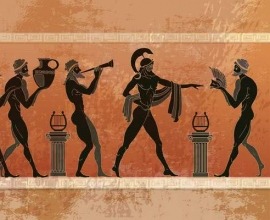History of New Year’s Resolutions
“I’m going to lose weight!”
“I’m going to eat healthier!”
“I’m going to sign up for a gym membership!”
These are some common New Year’s resolutions that people make after they ring in the New Year. But why do we set goals for ourselves at this time of the year when we can literally make them at any other time? Well the tradition of making New Year’s resolutions dates back over 4000 years to the Ancient Babylonians.[1] The Babylonians celebrated a 12-day festival called Akitu where they would honor the “rebirth of the natural world” by planting crops, crowning a new king, pledging vows to their gods and settling debts.[2]
Sound familiar? It should because these are the roots of our modern day New Year’s resolutions traditions only the Babylonians were more apt at seeing their goals through because they believed that if they kept their vows they made to the gods, they would be spared their wrath and remain in their good books.[3] The Babylonians also made their resolutions in March instead of January because it coincided with the spring harvest and their goals were more focused on external improvement rather than self-improvement.[4]

In Ancient Rome, a custom similar to New Year’s resolutions can also be found. Before Rome became a powerful empire, on March 1st, city magistrates would stand before the Roman Senate to affirm that they had performed their duties in accordance with the written laws.[5] In 27 BC, when Rome became an empire, New Year’s became a time for soldiers and city leaders to swear fealty to the Emperor.[6]
In 300 BC, Rome switched from celebrating New Year’s at the beginning of March to the beginning of January because as a military society, the crucial battle season was in spring, making the original March swear-in date for soldiers too late.[7] January was also seen as a more symbolic time to ring in the new year and make resolutions because it was a month associated with Janus, God of Hearth and Home. Janus was also depicted to have two faces – one facing backwards and one facing forward and this symbolized the end of the old year and the beginning of the new year.[8]
While our modern day New Year’s resolutions traditions differ to the traditions upheld in Ancient Rome or Babylonia, the urge for a clean slate at the beginning of the year remains a persistent aspect of Western Civilization.[9] The first recorded use of the phrase, “New Year’s Resolution” can be traced back to 1813 in a Boston newspaper and people feel more motivated to turn over a new leaf at the beginning of a new year because they feel like they can leave their troubles and past behind and start anew with the new year.[10]

In conclusion, the tradition of making New Year’s resolutions are older than people think through the actual types of promises people make nowadays differ greatly to those of the Ancient Babylonians or Romans. While their resolutions were rooted in religion and external societal obligations, modern day resolutions are mostly centered around self-improvement. However, as people don’t fear the wrath of god quite as much as people did back in the ye ole’ days, many resolutions made on New Year’s quickly fall to the wayside by the end of January. This is possibly why there is an uptick in weight loss procedures such as gastric balloon, and plastic surgery like tummy tucks.
Sources:
[1] Dwyer, Kate, ‘The History of New Year’s Resolutions’, in Teen Vogue, published December 31st, 2017, viewed on December 15th, 2018, https://www.teenvogue.com/story/new-years-resolutions-history
[2] ibid
[3] ibid
[4] Pappas, Stephanie & Geggel, Laura, ‘Why We Make New Year’s Resolutions’, in LiveScience, published December 31st, 2013, updated December 31st, 2017, viewed on December 15th, 2018, https://www.livescience.com/42255-history-of-new-years-resolutions.html
[5] ibid
[6] ibid
[7] ibid
[9] Pappas, Stephanie & Geggel, Laura, ‘Why We Make New Year’s Resolutions’, in LiveScience, published December 31st, 2013, updated December 31st, 2017, viewed on December 15th, 2018, https://www.livescience.com/42255-history-of-new-years-resolutions.html
[10] Dwyer, Kate, ‘The History of New Year’s Resolutions’, in Teen Vogue, published December 31st, 2017, viewed on December 15th, 2018, https://www.teenvogue.com/story/new-years-resolutions-history














